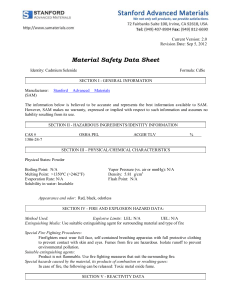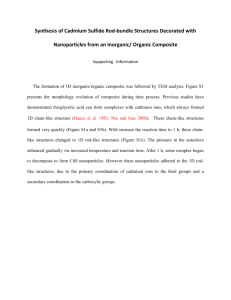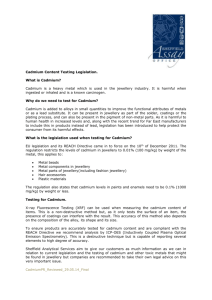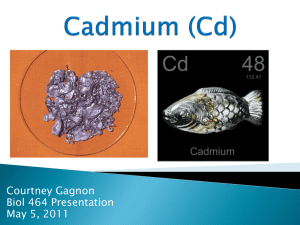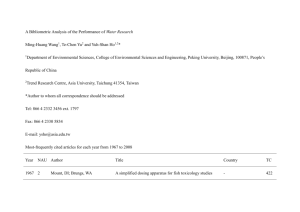Effect of an industrial chemical waste on the uptake
advertisement
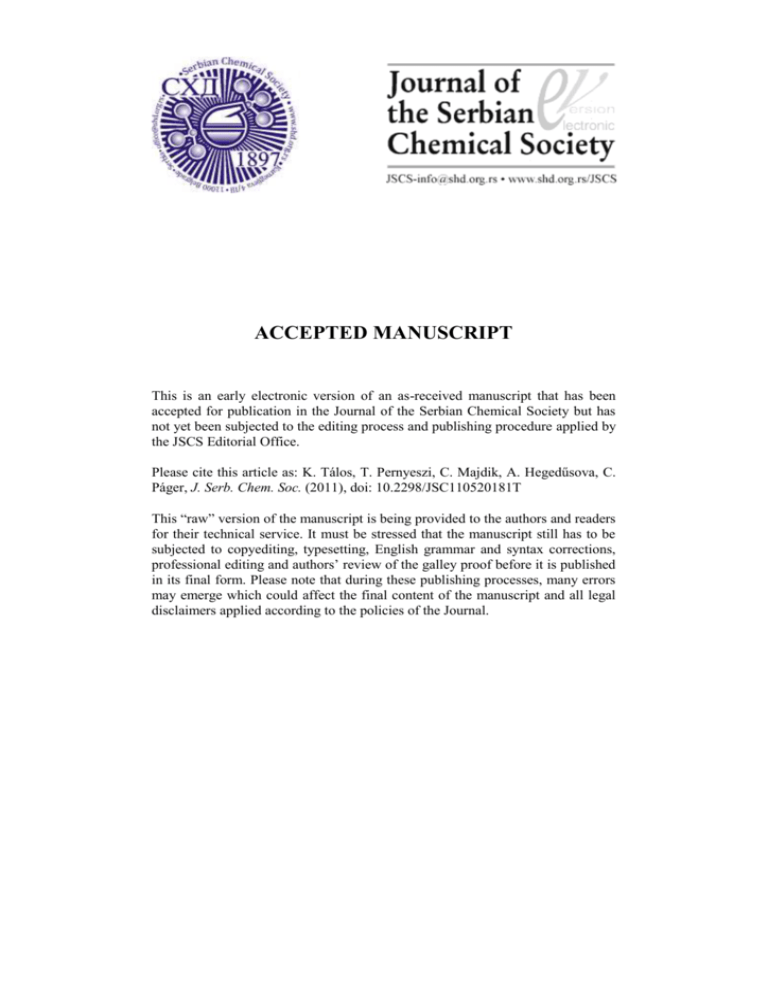
ACCEPTED MANUSCRIPT This is an early electronic version of an as-received manuscript that has been accepted for publication in the Journal of the Serbian Chemical Society but has not yet been subjected to the editing process and publishing procedure applied by the JSCS Editorial Office. Please cite this article as: K. Tálos, T. Pernyeszi, C. Majdik, A. Hegedűsova, C. Páger, J. Serb. Chem. Soc. (2011), doi: 10.2298/JSC110520181T This “raw” version of the manuscript is being provided to the authors and readers for their technical service. It must be stressed that the manuscript still has to be subjected to copyediting, typesetting, English grammar and syntax corrections, professional editing and authors’ review of the galley proof before it is published in its final form. Please note that during these publishing processes, many errors may emerge which could affect the final content of the manuscript and all legal disclaimers applied according to the policies of the Journal. J. Serb. Chem. Soc. 76 (0) 1–21 (2011) JSCS–5114 UDC Original scientific paper 1 Cadmium biosorption by baker’s yeast in aqueous suspensions 2 3 KATALIN TÁLOS1, TÍMEA PERNYESZI1*, CORNELIA MAJDIK2, ALZBETA HEGEDŰSOVA3 and CSILLA PÁGER1 4 5 6 7 8 1University of Pécs, Faculty of Science, Department of Analytical and Environmental Chemistry, 6 Ifjúság, H-7624 Pécs, Hungary, 2University Babeş-Bolyai, Faculty of Chemistry and Chemical Engineering, 11 Arany J., RO-400293 Cluj-Napoca, Romania and 3Department of Chemistry, Faculty of Natural Sciences, Constantine the Philosopher University, Tr. A. Hlinku 1, SK-949 01, Nitra, Slovakia 9 (Received 20 May, revised 30 August 2011) 10 11 12 13 14 15 16 17 18 19 20 Abstract: The biosorption of cadmium from artificial aqueous solutions using native baker’s yeast was investigated. The highest metal uptake value was 110 mg g–1 yeast in a suspension of 0.3 g L–1. The effect of pH, initial cadmium concentration, adsorption time and biosorbent dosage on biosorption by baker’s yeast was studied. The maximum biosorption capacity of yeast for cadmium was observed at pH 6.0. The adsorption equilibrium was reached within sixty minutes and the sorption process followed pseudo second-order kinetics. Cadmium biosorption isotherms were determined in the cadmium concentration range of 10 – 500 mg L–1 at pH 6 in a suspension of 0.3 g L–1. For evaluation of biosorption equilibrium, Langmuir and Freundlich equations were applied to the experimental data. 21 22 Keywords: cadmium; baker’s yeast; biosorption; pH; kinetics; isotherm; biosorbent dosage. 23 24 25 26 27 28 29 30 31 32 33 INTRODUCTION Heavy metal pollution has become one of the most serious environmental problems today. Cadmium is a heavy metal that poses serious health hazards through entry into the food chain by anthropogenic pathways. In the last decade, biosorption using microbial biomasses as sorbent materials has emerged as a cost-effective removal technique for the treatment of high volume and low concentration complex wastewaters containing heavy metal(s) at concentrations in the order of 1 to 100 mg L–1 metal, compared to other processes such as chemical precipitation, evaporation, ion exchange and membrane separation. The conventional methods have disadvantages, including incomplete metal removal, requirements for expensive equipment and monitoring systems, high reagent or * Corresponding author. E-mail: ptimea@ttk.pte.hu doi: 10.2298/JSC110520181T 1 2 34 35 36 37 38 39 40 41 42 43 44 45 46 47 48 49 50 51 52 53 54 55 56 57 58 59 60 61 62 63 64 65 66 67 68 69 70 71 72 73 TÁLOS et al. energy requirements or generation of toxic sludge or other waste products that require disposal.1–3 The utilization of microorganisms (bacteria, fungi, yeast and algae) as biosorbents (biosorption) offers a potential alternative for heavy metal detoxification and the recovery and reuse of toxic/precious metals.4 In the concept of biosorption, several physical or chemical processes may be involved, such as physical and/or chemical adsorption, ion exchange, coordination, chelation and microprecipitation. Biomass cell walls, consisting mainly of polysaccharides, proteins and lipids, offer many functional groups, such as carboxylate, hydroxyl, sulfate, phosphate and amino groups, which can bind metal ions.2,5 Some potential biomaterials with high metal-binding capacity have been identified in part. Algae, bacteria, fungi, yeast and waste microbial biomass from the fermentation and food industry are amongst them. For economic reasons, researchers have paid much attention to various by-products from the fermentation industry. The application of these waste microbes as biosorbents for the biosorption of heavy metals and radionuclides is to kill two birds with one stone because it uses waste to dispose of waste. The enterprises can sell their waste biomass and earn money, simultaneously, they can save the cost associated with disposing of the waste biomass they produced.2,5–9 A biomass used as a biosorbent must be selective and inexpensive.6,9 Among the promising biosorbents for heavy metal removal, Saccharomyces cerevisiae (S. cerevisiae) is still under consideration as a biomaterial due to its unique nature in spite of its mediocre capacity for metal uptake compared with other fungi. Yeast fungi are widely used for food and beverage production, are easily cultivated using cheap media, are also, as waste of the fermentation industry, a by-product produced in large quantities, and are easily manipulated at the molecular level.2,6–8 Yeasts have been studied in various forms, for example living cell/dead cell, intact cell/deactivated cell, immobilized cell/free cell, raw material/pretreated cell by physicochemical process, wild type/mutant cells, flocculent/non-flocculent cells, engineered/ non-engineered cells, lab culture/waste industrial cell, and cells from different industries.2,6–11 However, little information exists on the use of commercial native baker’s yeast as a biosorbent for metal removal. Yeast biosorption depends on several parameters, such as pH, the ratio of the initial metal ion and initial biomass concentrations, culture conditions, the presence of various ligands and competitive metal ions in solution, and on temperature to a limited extent.2,9,12– 15 The objectives of this study were: to test the recycling of native commercial baker’s yeast biomass as a sorbent material for the immobilization of cadmium in polluted water, CADMIUM BIOSORPTION BY BAKER’S YEAST 3 74 75 76 77 78 79 80 to evaluate using batch technique the influences of different experimental parameters, such as pH, sorption time, cadmium concentration and biosorbent dosage, on biosorption, to model cadmium biosorption kinetics by yeast using a second-order kinetic equation, to determine adsorption isotherms using batch technique and analyze the adsorption equilibrium using the Freundlich and Langmuir isotherm equations. 81 82 83 84 85 86 87 88 89 90 91 92 93 94 95 96 97 98 99 100 101 102 103 104 105 106 107 108 109 110 111 112 113 114 115 EXPERIMENTAL Fungal biomass The biosorbent was fresh and compressed baker’s yeast (commercial yeast, “Budafok” Yeast and Spirit Factory, Budapest, Hungary). The baker’s yeast was used as the sorbent material in natural commercial form. Its water content was 70 %. The determination of the water content was performed according to the protocol of the yeast factory. Chemicals Cadmium nitrate (Cd(NO3)2·4H2O) (purity >99 %) was purchased from Fluka (Switzerland) and used without further purification. The stock solution was prepared by dissolving 1.3718 g Cd(NO3)2.4H2O in 1.0 L of distilled water. The test solutions were prepared by diluting 500 mg L–1 of stock solution to the desired concentrations. The cadmium concentration of the prepared test solutions varied between 5 – 500 mg L–1 in the sorption experiments. The pH of the suspensions was adjusted to the required value with 0.1 M HCl or 0.1 M NaOH solutions (Merck, Germany). Analyses of cadmium The concentration of cadmium was determined by atomic absorption spectrophotometry (Perkin – Elmer 2380) at 228.8 nm. The calibration of cadmium was made with standard cadmium solution (Scharlau, Germany) in the concentration range of 0 – 2.5 mg L–1. Effect of pH on the biosorption The effect of pH on cadmium adsorption by baker’s yeast was investigated using a 0.3 g L–1 suspension of baker’s yeast and an initial cadmium concentration of 50 mg L–1. The initial pH of the yeast suspension was 5.6, which was adjusted to the desired value in the range 2–11. Zeta potential measurements The zeta potential of aqueous suspensions of baker’s yeast was measured with Zetameter instrument (Malvern Zetasizer nano ZS, UK). The suspensions were made from baker’s yeast and distilled water. The suspensions contained 0.3 g L–1 yeast. After pH adjustment, the suspensions were stirred on a magnetic stirrer for 30 minutes and then the zeta potential was measured. Kinetics study of biosorption In the kinetics study of cadmium biosorption by baker’s yeast, the concentrations of the metal ions were 5, 10, 25 and 50 mg L–1 at a suspension concentration of 0.3 g L–1. The experimental time was 180 minutes. During the first 30 minutes of agitation at 250 rpm, samples were taken every 5 minutes, in the following 30 minutes every 10 minutes and in the following 2 hours every 15 minutes. The samples were centrifuged at 5500 rpm for 10 minutes and the supernatants diluted for analysis by atomic absorption spectrophotometry. 4 116 117 118 119 120 121 122 123 124 125 126 127 128 129 130 131 132 TÁLOS et al. Determination of biosorption isotherms Biosorption experiments were performed in the batch mode for the determination of the adsorption isotherms. The concentrations of baker’s yeast in the suspensions were 0.3, 0.6, 1.5 and 3.0 g L–1. The initial concentration of cadmium was varied between 10–500 mg L–1. A defined mass of biosorbent and a defined volume of cadmium solution were placed in a testtube. The tubes were agitated on a shaker at 150 rpm at a constant temperature (22.5 1 °C). Samples were taken at given time intervals (after 24 h) and then centrifuge at 5500 rpm for 10 min. The supernatants were used for analysis of the residual amount of cadmium. The adsorbed amount of cadmium at time t, qt (mg g–1), was obtained as follows: qt c0 ct V m (1) where c0 and ct are the initial and at time t liquid phase cadmium concentrations (mg L–1), V is the volume of the solution (L) and m is the mass of the dry biomass used (g). Correspondingly, the adsorbed amount of cadmium at equilibrium, qe (mg g–1), is given by: qeq c0 ceq V m (2) where ceq is the concentration of cadmium in the supernatant at equilibrium (mg L–1). RESULTS AND DISCUSSION 133 Effect of solution pH and zeta potential on the adsorption of cadmium 134 135 136 137 138 139 140 141 142 143 144 145 146 147 148 149 150 151 152 Previous studies on heavy metal biosorption showed that the pH value of the solution is an important factor in both the solution chemistry of the metal and the surface characteristics of the biosorbent.2,5,9,13–18 The effect of the initial pH on cadmium biosorption by yeast biomass is presented in Fig. 1. The biomass concentration was 0.3 g L–1 and the initial metal concentration was 50.0 mg L–1. The cadmium biosorption capacity of biosorbent increased with increasing pH from 2.0 to 6.0. The highest metal uptake value obtained for cadmium was 42.9 mg g–1. At the pH values of greater than pH 8.0, the cadmium ions precipitated as Cd(OH)2 due to the increasing concentration of OH– in the solution. For this reason, the experiments were not conducted at higher pH values. It is well known that at low pH values, cell wall ligands are closely associated with hydronium ions, which restrict the approach of positively charged metal ions because of the repulsive force. As the pH increases, more ligands carrying negative charges would be exposed, with the subsequent attraction of metal cations and biosorption onto the binding sites on the cell surface.7 The values of the zeta potential of the biomass at different pH values are shown in Fig. 2. The zeta potential value of the biomass was –0.61 at pH 2.2 and the overall surface of the biomass was negatively charged at the pH values between 2.2 and 11.0. The zeta potential values varied from –0.61 mV at pH 2.2 to –35.8 mV at pH 11. CADMIUM BIOSORPTION BY BAKER’S YEAST 5 153 154 155 156 157 158 159 160 161 162 163 164 Several researchers have also investigated the effect of pH on the biosorption of cadmium by microbial biomass and similar results were reported. Shu-Juan et al. found that the adsorption rate of cadmium by S. cerevisiae from a brewery is low when the pH is lower than 4.0. Better adsorption results were obtained in the pH range of 4.0–7.0, and the percent adsorption reached 83.7 % when the pH was 6.0.18 Vasudevan et al.14 also reported that the cadmium ion adsorption capacity of a commercial yeast increased with increasing pH and it had a maximum at pH 6.5.14 Experiments were not conducted beyond pH 7.0 to avoid possible hydroxide precipitation.14 Göksungur et al.5 studied cadmium and lead biosorption by ethanol-treated waste baker’s yeast. The maximum biosorption of the heavy metal ions by the yeast were observed at pH 6.0 for cadmium and at pH 5.0 for lead.2 165 Effect of contact time and initial cadmium concentration on biosorption 166 167 168 169 170 171 172 173 174 175 176 177 178 179 180 181 182 183 184 185 186 187 188 189 190 191 Adsorption equilibrium studies are important to determine the efficiency of adsorption. With the purpose of investigating the mechanism of biosorption and its potential rate-controlling steps that include mass transport and chemical reaction processes, kinetic models have been exploited to test the experimental data. Adsorption kinetics is expressed as the solute removal rate that controls the residence time of the sorbate at the solid–solution interface. The kinetics of cadmium adsorption was investigated using a concentration of baker’s yeast in the suspension of 0.3 g L–1 at pH 6. The initial cadmium concentrations were 5.0, 12.5, 25.0 and 50.0 mg L–1. The amounts of adsorbed cadmium against the adsorption time are presented in Fig. 3a. The biosorption process of heavy metal by S. cerevisiae usually occurs rapidly.2,4,13,14 The adsorption rate was higher in the first thirty minutes and then decreased until equilibrium was reached. Similar trends were found by other workers.2,14 By investigating the biosorption of Cr(VI) and Fe(III) on Streptococcus equisimilis, S. cerevisiae and Aspergillus niger, Goyal et al.19 confirmed that metal uptake by the microorganisms proceeds in two stages: a passive uptake that occurs immediately and an active uptake that progresses slowly.19 The first stage is thought to be physical adsorption or ion exchange at the cell surface, reaching the adsorption equilibrium within 30–40 min at the end of the rapid physical adsorption. Vasudevan et al. found that the process of cadmium biosorption by inactive and protonated cells of S. cerevisiae was dependent on the availability of metal ion in aqueous solution or the metal ion concentration.14 However, the researchers suggested that the adsorption process occurred in four distinct steps and the rates for these steps decreased sequentially. The rate of cadmium (II) uptake in each case was pseudo second-order, with respect to the metal ion 6 TÁLOS et al. 192 193 194 195 196 197 198 199 200 201 concentration. It should be noticed that the adsorption of cadmium increased with increasing sorption time.4,12 When the initial cadmium concentration was 5.0 mg L–1, the adsorption equilibrium was attained within 5 minutes, while when it was 12.5, 25.0 or 50.0 mg L–1, equilibrium was reached within 60 minutes. In adsorption equilibrium, at an initial cadmium concentration of 5.0 mg L–1, the maximal adsorbed cadmium amount qeq,exp was 16.5 mg g–1, at an initial concentration of 12.5 mg L–1, qeq,exp was 20.1 mg g–1, at initial concentration of 25.0 mg L–1, qeq,exp was 36.5 mg g–1 and at initial concentration of 50 mg L–1, qeq,exp was 60.7 mg g–1. 202 Kinetic modeling 203 204 205 206 207 208 209 210 211 212 213 214 215 The pseudo first- and second-order kinetic models are the most employed models to study the biosorption kinetics of heavy metals and to quantify the extent of uptake in biosorption kinetics.9,12,16,21 For an evaluation of the cadmium bioadsorption kinetics, two kinetic models were used to fit the experimental data at 5.0, 12.5, 25.0 and 50.0 mg L–1 initial cadmium concentrations at pH 6. The pseudo first-order Lagergen model could not be applied to the experimental results of the kinetics of cadmium biosorption by baker’s yeast, as the correlation coefficients for the pseudo first-order kinetics were lower than those for the pseudo second-order one. For this reason, the application of the pseudo second-order kinetic model will be pursued for an evaluation of the cadmium bioadsorption kinetics. If the sorption rate is second-order, the pseudo second-order kinetic rate equation is expressed as:22 2 dq (2) k2,ad qeq q dt where k2,ad is the rate constant of the second-order biosorption (g mg–1∙min–1). After integration, the following equation is obtained: t 1 t (3) 2 q k2,ad qeq qeq 216 217 218 219 220 221 222 223 224 225 226 227 It should be noticed that for the utilization of this model, it is not necessary for the experimental value of qeq to be pre-estimated. By plotting t/q against t for the initial concentrations (5.0, 12.5, 25.0, 50.0 mg L–1), straight lines were obtained, as shown in Fig. 3b. The values of the second-order rate constants k2,ad and qeq, determined from the slopes and intercepts of the plots, respectively, are presented in Table I. The correlation coefficients for the second-order kinetic model were close to 1.0 for all cases, and the theoretical values of qeq also agreed well with the CADMIUM BIOSORPTION BY BAKER’S YEAST 7 228 229 230 231 232 233 experimental data (Table I). The values of second-order rate constant k2,ad were in the range of 4.6 x 10–4 – 2.2 x 10–1 g mg–1∙min–1. This suggests that the sorption of cadmium by baker’s yeast follows second-order kinetics. The secondorder kinetic parameters can be used to determine the equilibrium sorption capacity, the percent removal of cadmium, the rate constants and the initial sorption rate to facilitate bioreactor design. 234 Adsorption isotherms 235 236 237 238 239 240 241 242 243 244 245 The adsorption isotherms of cadmium adsorption by baker’s yeast were determined in aqueous suspension using the batch technique. The adsorption isotherms of the adsorption of cadmium ions by baker’s yeast in the initial concentration range of 10 – 500 mg L–1 are displayed in Fig. 4a. The adsorption isotherms determined in the low concentration range of 5–25 mg L–1 are shown in Fig. 4b. The biomass concentration was 0.3 g L–1 in both cases. It can be observed from Fig. 4a and 4b that the uptake of cadmium by the biomass almost linearly increases with increasing initial cadmium concentration in solution. At an equilibrated concentration of 136.9 mg L–1 (c0 = 214 mg L–1), qeq,exp = 263.8 mg g–1 and at (c0 = 52 mg L–1) an equilibrated concentration of 32.6 mg L–1 (c0 = 52 mg L–1), qeq,exp = 59.9 mg g–1. 246 Equilibrium modeling 247 248 249 250 251 252 253 The analysis of equilibrium is important for developing a model that can be used for the design of biosorption systems. Several isotherm equations have been used for equilibrium modeling of biosorption systems.12 Two classical adsorption models, Langmuir and Freundlich isotherms, are the most frequently employed. In this work, the Freundlich and Langmuir models were used to describe the relationship between the amounts of cadmium adsorbed and its equilibrium concentration in solution. 254 Freundlich isotherm 255 256 257 258 The Freundlich isotherm is capable of describing the adsorption of organic and inorganic compounds onto a wide variety of adsorbents, including biosorbents. The Freundlich equation based on sorption onto a heterogeneous surface is: 259 1/n qeq KFCeq 260 261 262 where KF and n are the Freundlich constants, which are indicators of the adsorption capacity and adsorption intensity of the sorbent. Eq. (4) can be linearized in logarithmic form as follows: 1 (5) log qeq log KF log Ceq n 263 (4) 8 TÁLOS et al. 264 265 266 267 268 269 270 A plot of log qeq vs. log Ceq has a slope with the value of 1/n and an intercept of log KF. log KF is equivalent to log qeq when 1/n equals unity. However, in other case, when 1/n 1, the KF value depends on the units in which qeq and Ceq are expressed. The experimental cadmium adsorption and nonlinearly fitted (using Gnuplot software) by Freundlich model isotherms can be seen in Fig 4a. The values of KF and n calculated are 6.5 [(mg g–1) (mg L–1)]n and 1.4, respectively (Table II).12,23 271 Langmuir isotherm 272 273 The Langmuir isotherm is valid for monolayer adsorption onto a surface with a finite number of identical sites. It is given as: qeq 274 275 276 277 278 279 Q 0bCeq 1 bCeq (6) where Ceq and qeq are equilibrium concentration (mg L–1) and the amount adsorbed at equilibrium time (mg g–1), respectively. Q0 and b are Langmuir constants related to the capacity and energy of adsorption, respectively. The linearized form of the Langmuir equation is: Ceq Ceq 1 (7) 0 qeq Q b Q 0 280 281 282 283 284 285 Q0 and b can be determined from a linear plot of Ceq/qeq vs. Ceq.8 The experimental cadmium adsorption and the non-linearly fitted (using Gnuplot software) by the Langmuir model isotherm can be seen in Fig. 4b. The calculated values of b and Q0 are 2.8∙10–3 L mg–1 and 852.6 mg g–1, respectively (Table II). The calculated monomolecular adsorption capacity Q0 is fits well to the experimental value. 286 Biosorption yield 287 288 289 290 291 292 The biosorption yields are presented against the suspension concentrations at an initial cadmium concentration of 50.0 mg L–1 in Fig. 5. The biomass concentrations were 0.3, 0.6, 1.5 and 3.0 g L–1. Increasing of biomass concentration from 0.3 g L–1 to 3.0 g L–1 caused the biosorption yield to increase up to 38 %. Above a biomass concentration of 1.5 g L–1, the biosorption yield did not change significantly. 293 CONCLUSIONS 294 295 296 297 298 The biosorption properties of waste baker’s yeast (S. cerevisiae) were studied for cadmium removal from aqueous suspension. The initial heavy metal concentration, pH of the solution and contact time were found to have an effect on the bioadsoption capacity of the biomass. The maximal biosorption capacity was determined at pH of 6.0. With increasing initial cadmium concentration and CADMIUM BIOSORPTION BY BAKER’S YEAST 9 299 300 301 302 303 304 305 306 307 contact time, the amount of cadmium adsorbed increased as well. The biosorption kinetics followed pseudo second-order kinetics. The Freundlich equation and the Langmuir adsorption model were used for a mathematical description of the biosorption of cadmium onto native baker’s yeast. It was found that the adsorption equilibrium data fitted well to the Freundlich and Langmuir models. With increasing biomass concentration, the adsorption efficiency increased significantly up to a biomass dosage of 1.5 g L–1. It seems that the use of readily available waste baker’s yeast from the fermentation industry offers an alternative in the removal of metals from contaminated waters. 308 309 310 311 312 313 314 Acknowledgements. Timea Pernyeszi, Katalin Tálos and Alžbeta Hegedűsova gratefully acknowledge support for this research from the Hungarian–Slovak Intergovernmental Cooperation Program (APVV SK–HU 0018-08, SK-18/2008) between the University of Pécs and Constantine the Philosopher University for 2009–2011. Timea Pernyeszi, Katalin Tálos and Cornelia Majdik gratefully acknowledge support for this research from the Hungarian– Romanian Intergovernmental Cooperation Program between University of Pécs and University of Babes-Bolyai for 2008–2009 (RO-15/2007). 315 316 317 318 319 320 321 322 323 324 325 326 327 328 329 330 ИЗВОД Испитана је биосорпција кадмијума из вештачких водених раствора помоћу изворног пекарског квасца. Највиша вредност преузете количине била је 110 mg g–1 у суспензији од 0,3 g L–1. Истраживани су утицаји pH, почетне концентрације кадмијума, адсорпционог времена и дозе биосорбента на биосорпцију помоћу пекарског квасца. Максимални капацитет биосорпције кадмијума квасцем био је уочен на pH 6. Адсорпциона равнотежа је била достигнута након 60 минута, а процес сорпције је пратио кинетику псеудо-другог реда. Изотерме биосорпције кадмијума одређене су у опсегу концентрација кадмијума од 10 до 500 mg L–1 при pH 6 у суспензији од 0,3 g L–1. За процену равнотеже биосорпције, на експерименталне податке су примењене Лангмирове и Фроиндлихове једначине. 331 (Примљено 20. маја, ревидирано 30. августа 2011) 332 333 334 335 336 337 338 339 340 BIOSORPCIJA KADMIJUMA PEKARSKIM KVASCEM U VODENOJ SUSPENZIJI KATALIN TÁLOS1, TÍMEA PERNYESZI1, CORNELIA MAJDIK2, ALZBETA HEGEDŰSOVA3 и CSILLA PÁGER1 1 University of Pécs, Faculty of Science, Department of Analytical and Environmental Chemistry, 6 Ifjúság, H-7624 Pécs, Hungary, 2University Babeş-Bolyai, Faculty of Chemistry and Chemical Engineering, 11 Arany J., RO-400293 Cluj-Napoca, Romania и 3Department of Chemistry, Faculty of Natural Sciences, Constantine the Philosopher University, Tr. A. Hlinku 1, SK-949 01, Nitra, Slovakia REFERENCES 1. 2. 3. 4. 5. 6. 7. Z. Aksu, G. Egretli, T. Kutsal, J. Environ. Health 34 (1999) 295 Y. Göksungur, S. Üren, U. Güvenc, Bioresour. Technol. 96 (2005) 103 P. A. Marques, J. A. Pinheiro, M. F. Rosa, Desalination 214 (2007) 343 F. Veglio, F. Beolchini, Hydrometallurgy 44 (1997) 301 Y. Göksungur, S. Üren, U. Güvenc, Turk. J. Biol. 27 (2003) 23 A. Kapoor, T. Viraraghavan, Bioresour. Technol. 53 (1995) 195 F. Ghorbani, H. Younesi, S. M. Ghasempouri, A. A. Zinatizadeh, M. Amini, A. Daneshi, Chem. Eng. J.145 (2008) 267 10 341 342 343 344 345 346 347 348 349 350 351 352 353 354 355 356 357 358 359 360 361 8. 9. 10. 11. 12. 13. 14. 15. 16. 17. 18. 19. 20. 21. 22. 23. TÁLOS et al. P. Marques, H. M. Pinheiro, M. F. Rosa, Desalination 214 (2007) 343 J. Wang, C. Chen, Biotechn. Adv. 24 (2006) 427 W. Jianlong, Process Biochem. 37 (2002) 847 A. Menegário, P. S. Tonello, S. F. Durrant, Anal. Chim. Acta 683 (2010) 107 J. Febrianto, A. N. Kosasih, J. Sunarso, Y. H. Ju, N. Indraswati, S. Ismadji, J. Hazard. Mater. 162 (2009) 616 P. Marques, H. M. Pinheiro, J. A. Teixeira, M. F. Rosa, Desalination 124 (1999) 137 P. Vasudevan, V. Padmavathy, S. C. Dhingra, Bioresour. Technol. 89 (2003) 281 Sz. Tonk, A. Măicăneanu, C. Indolean, S. Burca, C. Majdik, J. Serb. Chem. Soc. 76 (2011) 363 Z. Aksu, Sep. Purif. Techn. 21 (2001) 285 A. Çabuk, T. Akar, S. Tunali, S. Gedikli, Chem. Eng. J. 131 (2007) 293 D. Shu-Juan, W. De-Zoou, Z. Dong-Qin, J. Chun-Yun, W. Yu-Juan, L. Wen-gangi, Trans. Nonferr. Metal. Soc. China 18 (2008) 1008 N. Goyal, S. C. Jain, U. C. Banerjee, Adv. Environ. Res. 7 (2000) 311 D. Brady, J. R. Duncan, Appl. Microbiol. Biotechnol. 41 (1994) 149 C. C. V. Cruz, A. C. A. da Costa, C. A. Henriques, A. S. Luna, Bioresour. Technol. 91 (2004) 249 Z. Aksu, S. Tezer, Process Biochem. 36 (2000) 431 A. Delle Site, J. Phys. Chem. Ref. Data 30 (2001) 187. CADMIUM BIOSORPTION BY BAKER’S YEAST 362 363 364 365 366 367 368 369 370 371 372 373 374 375 376 377 378 379 380 381 382 383 384 385 386 387 388 389 11 CAPTIONS Fig. 1. The effect of pH on cadmium biosorption on baker’s yeast. The biomass concentration was 0.3 g L–1 and the initial cadmium concentration was 50 mg L–1. Fig. 2. Effect of pH on the zeta potential of baker’s yeast cells in aqueous suspension. The biomass concentration was 0.3 g L–1. Figs. 3. (a) The effect of the initial cadmium concentration on the kinetics of cadmium sorption by baker’s yeast. (b) Linearized pseudo second-order kinetic model for cadmium adsorption by baker’s yeast at different initial cadmium concentrations. Initial concentrations: 5.0 (♦); 12.5 (●); 25.0 (▲); 50.0 (■) mg L–1, temperature: 22.5 °C, biomass concentration: 0.3 g L–1. Figs. 4. Adsorption isotherms of cadmium by baker’s yeast from aqueous solutions at a biomass concentration of 0.3 g L–1 and initial cadmium concentrations in the range (a) 0 – 500 mg L–1 ♦ experimental data, □ non-linear fitted data using the Freundlich equation, (b) ♦ experimental data, □ non-linear fitted data using the Langmuir equation. (c) Adsorption isotherm in the initial concentration range of 5 – 25 mg L–1. Fig. 5. Effect of the suspension concentration of biomass on cadmium biosorption onto baker’s yeast. The initial cadmium concentration was 50.0 mg L–1. TABLE I. The second-order adsorption rate constants of cadmium adsorption for different initial concentrations, at pH 6.0, temperature: 22.5 °C, biomass concentration: 0.3 g L–1. TABLE II. Bioadsorption isotherm constants for the biosorption of cadmium onto baker’s yeast. 12 390 TÁLOS et al. Fig. 1. 50 30 q / mg g -1 40 20 10 0 0 2 4 pH 391 392 6 8 13 CADMIUM BIOSORPTION BY BAKER’S YEAST 393 394 Fig. 2. 0 z / mV -10 -20 -30 -40 -50 0 395 396 2 4 6 pH 8 10 12 14 397 398 TÁLOS et al. Fig. 3. 3a 80 q / mg g -1 60 40 20 0 0 399 400 50 100 150 200 t / min 3b (t/q) / min g mg -1 12 10 8 6 y = 0.0603x + 0.0162 2 R =1 y = 0.0497x + 0.1616 2 R = 0.9611 y = 0.025x + 0.2918 2 R = 0.9811 y = 0.0134x + 0.3878 2 R = 0.9786 4 2 0 0 401 402 50 100 t / min 150 200 15 CADMIUM BIOSORPTION BY BAKER’S YEAST TABLE I. 403 404 co (mg L–1) 5.0 12.5 25.0 50.0 405 k2,ad (g mg–1 min–1) 2.2·10–1 1.5·10–2 2.1·10–3 4.6·10–4 qeq,cal (mg g–1) 16.6 20.1 40 74.6 R2 1.000 0.961 0.981 0.979 qeq,exp (mg g–1) 16.5 20.1 36.5 60.7 16 406 407 TÁLOS et al. Figs. 4. 4a 500 q / mg g -1 400 300 200 100 0 0 408 409 100 200 300 c e / mg L-1 400 4b 500 300 q / mg g -1 400 200 100 0 0 410 411 100 200 300 -1 c e / mg L 400 17 CADMIUM BIOSORPTION BY BAKER’S YEAST 4c 412 40 q / mg g -1 60 20 0 0 413 414 10 20 c e / mg L-1 30 40 18 TÁLOS et al. TABLE II. 415 416 KF/ [(mg g–1)(mg L–1)]n Langmuir isotherm Freundlich isotherm 417 418 6.5 n 1.4 b/ L mg–1 Q0/ mg g–1 2.8∙10–3 852.6 19 CADMIUM BIOSORPTION BY BAKER’S YEAST Fig. 5. 419 Biosorption yield, % 40 30 20 10 0 0 2 4 6 8 Suspension concentration, g L-1 420 10

